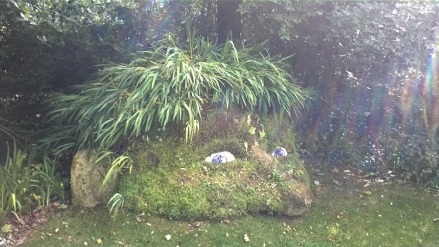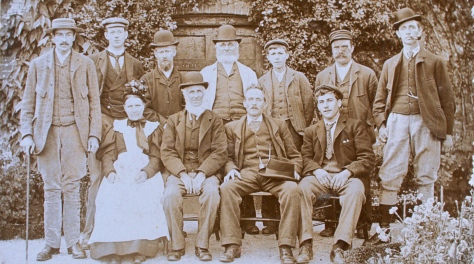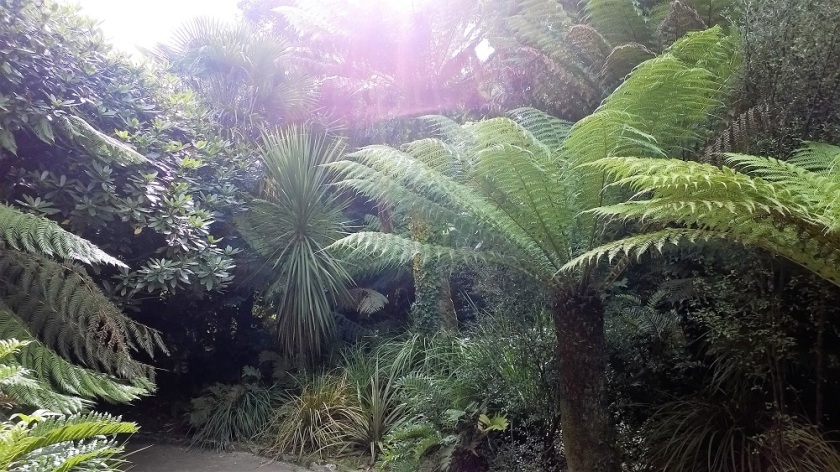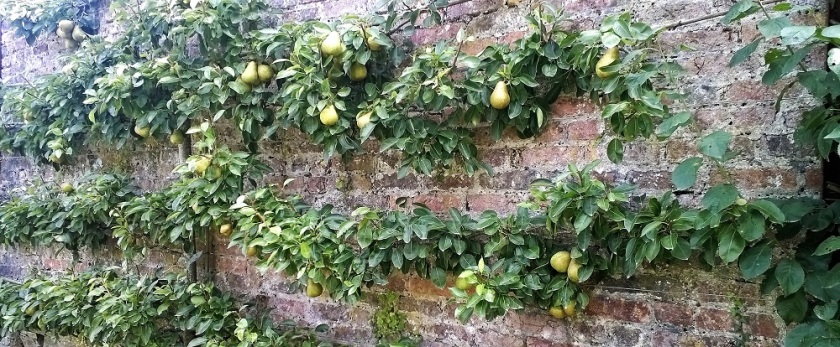Yesterday Bernie & I visited the Lost Gardens of Heligan. I have wanted to go there for years – since well before the notion of moving here came into being. I’ve come close once or twice and it’s never quite happened. Finally, we’ve managed it – on a balmy afternoon in mid-September when everything colluded to give me an experience to treasure.
There’s always a danger after waiting so long, that a visit like this will be a disappointment. Expectations will be dashed. We didn’t have much time and so only managed to explore the gardens. The estate – which is very much larger – is still to come. But just a few hours in the gardens is enough for me to know that I shall never be disappointed here. It is beautiful and I love it. I suspect that Heligan has just topped my personal list of beautiful, evocative and romantic gardens – and that’s saying a lot.
The late summer flowers were colourful and abundant. But this is not a plantsman’s garden. Yes, there are beds and borders, shrubs and trees, but I’ve seen equal or better examples in many places.

It’s the story of Heligan – and the spirit of Heligan – that makes it stand out for me, and infuses it with history, love and passion in a way that I’ve not felt elsewhere.

At the moment I only know the bare bones of the story. In fact there are two stories. There is the more recent story of the restoration of a garden that had been long neglected and had slipped into decay and decline. And there is the story of the garden before it was lost to time: when it was a thriving community, owned by the Tremayne family for generations.
This earlier story came to a tragic close after the First World War. As war was declared, the property was owned by Jack Tremayne: a military man, but by then too old to serve. At least thirteen men from the gardening staff at Heligan went to war. And all five of Jack Tremayne’s nephews served. (He had not married and had no children himself.) Two of those nephews lost their lives. And of the thirteen staff, only four men survived. Soon after the war, Jack Tremayne left Heligan, saying he “couldn’t live with the ghosts”. And thus it remained forgotten until 1990, when the present-day descendent of the Tremaynes and Tim Smit (of the Eden Project) embarked on the enormous task of restoring the gardens to what they once were.
Around the gardens are evocative portraits and brief accounts of the men lost from Heligan. I don’t know if these are permanent fixtures or will remain only for the duration of the centenary of the War. I hope they remain. They are not obtrusive; you happen across them in quiet places – where you imagine that these men once worked. To visualise them within the peace and tranquillity of these potting sheds and glasshouses and transplant them amidst the noise, filth and squalour of war sent shivers down my spine. To contemplate the contrast between working these long rows of beans and lettuces – hoe in hand – and crouching in a muddy trench clutching a bayoneted rifle is almost impossible.

History is everywhere. I almost wrote ‘living history’ and stopped myself because I am talking about men now long dead – but it IS living history: this garden is overflowing with living history. It’s not necessary to dwell on the wartime connections; they didn’t detract from my enjoyment of the present-day glory of the garden. I suspect though, that this is the most visceral experience I’ve encountered of how it may have felt to be uprooted from a life where you knew who you were and where you were – where you nurtured and tended the land in order to nurture and feed others, and then to find yourself deposited in a landscape where you were required not to nurture and tend and grow, but to destroy – both the land and the peoples that share it.
The various dovecotes that we came across seemed particularly poignant.
And so … the garden itself:
The rhododendron trees are amazing. I’ve never before seen trees like these, only shrubs and bushes. I loved how the light played on and around the delicate twisted trunks and branches.

There is a section of the garden called ‘New Zealand’ – of immediate interest to me because of B being a Kiwi. I don’t know yet why that section is there – no other country is explicitly represented – but it’s a beautiful, lush and tranquil area to wander through.

There are some charming little formal gardens with fountains and ponds…

… and many delightful doorways.
The large cutting garden and an even larger vegetable garden are both wonderful.

Surrounded by mellow old walls (often shored up), with present day staff working in both – even with us visitors wandering about I could see the ghosts of staff from forgotten eras, and ghosts of the family undertaking the development of the garden with care and vision.
Evidence of productivity and the ongoing restoration was to be seen in many a quiet corner.
The restoration of the greenhouses is stunning.

I am still drooling over some of them.
The pineapple pit is a delight.
Everywhere there are signs of productivity, passion, history and love.

I could write about what we saw for pages; I have scarcely scratched the surface. And the photographs say only a fraction of what I’d like to express.
The Gardens of Heligan spoke to me in a way that few places have done – especially cultivated places. I find myself quite content to say nothing more and instead to quietly absorb the experience, knowing I shall visit often and that each time I’ll take in a little bit more of the spirit that is Heligan…















This is definitely a must visit for me the next time we get to Cornwall. I won’t bother going to the Eden Project though.
Pollock House in Glasgow has a memorial plaque in the park/estate to all the men who had staffed the place and didn’t survive the war, very sad.
LikeLike
I’m not a huge fan of the Eden Project either though with it being so close to us I’m sure we will pop in every so often. (And I’m looking forward to the concert season there next year.) But Heligan – most definitely you should go next time you’re down here!
LikeLiked by 1 person
Lovely. This is a place I have long wanted to visit and yet each time we’ve been in Cornwall we’ve never been. Next time though …
I have been to the Eden Project and it is an ‘experience’. I loved parts and not so keen on other parts. It wasn’t helped by the large crowds there, but I suppose that is inevitable (: Our visit to the Eden Project was in 2008 and that is actually the last time we went to Cornwall and most of our visits were probably before the Gardens of Heligan were restored and open to the public.
LikeLike
Definitely make time for it when you’re next in Cornwall, Margaret. I suspect I’ll have more posts about it: I can see myself going all the time!
LikeLike
My introduction to the Lost Gardens was via Monty Don. I think he spoke about the New Zealand garden but I can’t remember what he told his TV viewers. Your post adds a whole lot more to my bare knowledge of the gardens. Wonderful. 🙂
LikeLiked by 1 person
It sounds like a dream – must definitely visit. I haven’t been to Cornwall since 1998 or so, high time I went back.
LikeLiked by 1 person
It sounds wonderful Sandra. I have wanted to go there for years. Maybe one day!
LikeLike
Maybe one day we will go together, Sue! 🙂 x
LikeLike
Ah, heavenly Heligan! We visited these gardens, and some of Cornwall’s other fabulous sites (Eden, of course, and Trebah particularly stick in my mind) – thank you so much for such a glorious opportunity to reminisce! 🙂
LikeLiked by 1 person
You are very welcome, Liz! 🙂
LikeLike
I’m loving Heligan already! Sounds absolutely FABULOUS!!!!!!!!!!!!!!!!!!
LikeLiked by 1 person
Wonderful! This is one of those places we’ve meant to visit for years but never quite reached – we really must.
LikeLike
I hope you get there one day, Jane. Definitely worth it 🙂
LikeLiked by 1 person
I am so glad you found me, so I could find you. This is a lovely post and a dream of a garden. Thank you. Thank you. Thank you.
LikeLiked by 1 person
I’m just having a trip through your early posts and find this gem. I’m so envious. This garden has been on my list of places I want to visit for years. I’ve seen other pictures, but it seems to me that everyone captures a different, special, aspect of it. A beautiful post, Sandra.
LikeLiked by 1 person
Thank you, Cath 🙂 I was exchanging comments with a fellow ‘Cornish’ blogger very recently and we both agreed that the marketing of Heligan seems to be pushing it towards families and children and ‘events’. None of which is a bad thing necessarily but the feel has changed I think. I shall try visiting later in the autumn when it may be quieter. (Meanwhile, I’m reminiscing on where 3 years has gone since I wrote this post!)
LikeLike